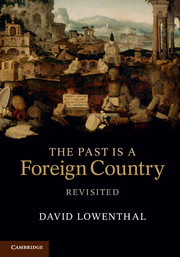Book contents
- Frontmatter
- Table of Contents
- List of illustrations
- List of permissions
- Acknowledgements
- List of abbreviations
- Introduction
- Part I Wanting the past
- Part II Disputing the past
- Part III Knowing the past
- Part IV Remaking the past
- 10 Saving the past: preservation and replication
- 11 Replacing the past: restoration and re-enactment
- 12 Improving the past
- Epilogue: the past in the present
- Select bibliography
- Index
- References
12 - Improving the past
from Part IV - Remaking the past
Published online by Cambridge University Press: 05 November 2015
- Frontmatter
- Table of Contents
- List of illustrations
- List of permissions
- Acknowledgements
- List of abbreviations
- Introduction
- Part I Wanting the past
- Part II Disputing the past
- Part III Knowing the past
- Part IV Remaking the past
- 10 Saving the past: preservation and replication
- 11 Replacing the past: restoration and re-enactment
- 12 Improving the past
- Epilogue: the past in the present
- Select bibliography
- Index
- References
Summary
We must add to our heritage or lose it.
George Orwell, 1941You don’t like the past? Then fiddle the books … How easy it is, as long as it’s just paper and fallible memory.
Robert Goddard, 1986If we need another past so badly, is it inconceivable that we might discover one, that we might even invent one?
Van Wyck Brooks, 1918The Byzantine Queen Helena [was] the most successful archaeologist in history. Whatever she looked for she promptly found hundreds of years after the event: the stable where Mary had given birth to Christ, the twelve stations of the cross, Calvary, the true cross, the nails, the lancet, the Holy Sepulchre and so on and on.
Yigael Yadin, quoted in Amos Elon, 1994Societies which cannot combine reverence to their symbols with freedom of revision must ultimately decay either from anarchy, or from the slow atrophy of a life stifled by useless shadows.
Alfred North Whitehead, 1927This chapter reviews why and how we change the past. We may be fully conscious, hazily cognizant, or wholly unaware of what impels us to revision. As shown in Chapters 10 and 11, efforts to save or retrieve the past are bound to alter it, no matter how much we strive to keep it as it was. Many seriously impact the past with no intent of doing so. Admirers of antiquity unwittingly mar its relics. Visitors who wear down the floor of Canterbury Cathedral seldom consider the cumulative impact of thousands of feet. Viewers whose breath and body heat imperil Lascaux’s prehistoric drawings ignore the corrosive effect of their presence.
- Type
- Chapter
- Information
- The Past Is a Foreign Country – Revisited , pp. 497 - 584Publisher: Cambridge University PressPrint publication year: 2015

